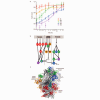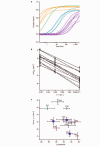An assembly landscape for the 30S ribosomal subunit
- PMID: 16319883
- PMCID: PMC1444899
- DOI: 10.1038/nature04261
An assembly landscape for the 30S ribosomal subunit
Abstract
Self-assembling macromolecular machines drive fundamental cellular processes, including transcription, messenger RNA processing, translation, DNA replication and cellular transport. The ribosome, which carries out protein synthesis, is one such machine, and the 30S subunit of the bacterial ribosome is the preeminent model system for biophysical analysis of large RNA-protein complexes. Our understanding of 30S assembly is incomplete, owing to the challenges of monitoring the association of many components simultaneously. Here we have developed a method involving pulse-chase monitored by quantitative mass spectrometry (PC/QMS) to follow the assembly of the 20 ribosomal proteins with 16S ribosomal RNA during formation of the functional particle. These data represent a detailed and quantitative kinetic characterization of the assembly of a large multicomponent macromolecular complex. By measuring the protein binding rates at a range of temperatures, we find that local transformations throughout the assembling subunit have similar but distinct activation energies. Thus, the prevailing view of 30S assembly as a pathway proceeding through a global rate-limiting conformational change must give way to one in which the assembly of the complex traverses a landscape dotted with various local conformational transitions.
Figures







Comment in
-
Biophysics: assembly line inspection.Nature. 2005 Dec 1;438(7068):566-7. doi: 10.1038/438566a. Nature. 2005. PMID: 16319867 No abstract available.
References
-
- Wimberly BT, et al. Structure of the 30S ribosomal subunit. Nature. 2000;407:327–39. - PubMed
-
- Schluenzen F, et al. Structure of Functionally Activated Small Ribosomal Subunit at 3.3 A Resolution. Cell. 2000;102:615–623. - PubMed
-
- Brodersen DE, Clemons WM, Jr., Carter AP, Wimberly BT, Ramakrishnan V. Crystal structure of the 30 S ribosomal subunit from Thermus thermophilus: structure of the proteins and their interactions with 16 S RNA. J. Mol. Biol. 2002;316:725–768. - PubMed
-
- Moazed D, Stern S, Noller HF. Rapid chemical probing of conformation in 16 S ribosomal RNA and 30 S ribosomal subunits using primer extension. J. Mol. Biol. 1986;187:399–416. - PubMed
Publication types
MeSH terms
Substances
Grants and funding
LinkOut - more resources
Full Text Sources
Other Literature Sources

